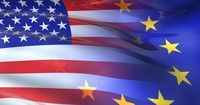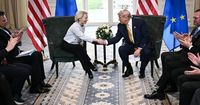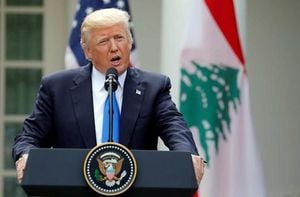On July 27, 2025, U.S. President Donald Trump and European Commission President Ursula von der Leyen announced a landmark trade deal at Trump’s Scottish golf resort that sets a 15% tariff on about 70% of European goods imported into the United States. This agreement, while averting a threatened 30% tariff escalation, has sparked a mix of relief, criticism, and concern across the Atlantic, revealing the complex dynamics of transatlantic trade relations and economic interests.
The deal marks a significant shift in the U.S.-EU trade relationship, imposing a 15% baseline tariff on European exports including cars, computer chips, and pharmaceuticals. This rate is notably lower than Trump’s earlier threats of tariffs as high as 50%, but it still represents a sharp increase from the 1.2% average tariff the U.S. applied to European goods in 2024. The deal also excludes certain strategic goods such as aircraft and aircraft parts, semiconductor equipment, certain chemicals, agricultural products, and critical raw materials from tariffs on both sides, signaling selective cooperation amid tension.
European companies are bracing for the economic impact. According to Capital Economics, the new tariffs could reduce the European Union’s gross domestic product by approximately 0.5%, with the average tariff on U.S. imports from the EU expected to surge to 17.5%. This increase is expected to raise prices for U.S. consumers and squeeze profits for European exporters, many of whom may have to choose between passing costs to customers or absorbing losses. Volkswagen, for example, reported a €1.3 billion ($1.5 billion) hit to profits in the first half of 2025 due to tariffs.
In the automotive sector, the deal reduces the U.S. tariff on European cars from 27.5% to 15%, a welcome relief but still a significant burden. Mercedes-Benz dealers in the U.S. anticipate “significant increases” in vehicle prices in the coming years despite some production taking place in Alabama. Meanwhile, the EU agreed to cut tariffs on American vehicles from 10% to 2.5%, with speculation that this could eventually drop to zero. German automakers, represented by the Association of the Automotive Industry (VDA), estimate the deal will cost them billions annually, adding pressure amid the costly transition to electric vehicles and global competition.
Energy trade is a focal point of the agreement. The EU committed to purchasing $750 billion worth of natural gas, oil, and nuclear fuel from the U.S. over three years, a strategic move as Europe continues to reduce its reliance on Russian energy. European companies also pledged to invest an additional $600 billion in the U.S., although this is a political commitment without legal binding.
However, the deal leaves significant issues unresolved. The 50% U.S. tariff on imported steel remains in place, with further negotiations planned to address global steel overproduction and establish import quotas. Pharmaceuticals, a major export from the EU to the U.S., were notably excluded from the main deal and remain on a “separate sheet of paper,” raising concerns about future tariff threats. Agricultural products, especially wine and spirits, also face uncertainty. Wine producers, particularly from Italy and France, fear the 15% tariff could inflict substantial losses—Italian winemakers estimate a €317 million hit over the next year, with affordable wines most at risk. The Wine & Spirits Wholesalers Association warns the tariffs could cost over 17,000 U.S. jobs and $2.5 billion (€2 billion) in business.
The reaction within Europe has been mixed and often critical. German Chancellor Friedrich Merz welcomed the deal as a means to avoid “an unnecessary escalation” in trade relations, emphasizing the preservation of core European interests. Conversely, senior French officials expressed sharp criticism. Strategy Commissioner Clément Beaune called the agreement “unequal and unbalanced,” lamenting that Europe failed to wield its economic power effectively. French Prime Minister François Bayrou described the deal as a “dark day” and “submission” by the EU, reflecting broader concerns about the bloc’s negotiating strength.
Industry groups have voiced concerns as well. Germany’s Federation of German Industries (BDI) labeled the deal an “inadequate compromise” and a “disastrous signal,” particularly due to the absence of a resolution on steel and aluminum tariffs. The German automotive sector warned that the tariffs will weigh heavily on manufacturers already navigating economic headwinds. Hungary’s Prime Minister Viktor Orbán, a strong Trump ally, criticized the deal as heavily favoring the U.S., quipping that Trump “ate Ursula von der Leyen for breakfast.”
Despite the criticisms, the deal brings a measure of stability and predictability to a fraught trade relationship. Carsten Brzeski, global chief macroeconomist at ING Bank, noted that while the agreement is not yet legally binding, it “would clearly bring an end to the uncertainty of recent months,” averting a risk that could have had severe consequences for the global economy.
Financial markets initially reacted with relief but then retreated as the full implications became clear. European stock indexes, including Germany’s DAX, closed lower with significant losses among automotive manufacturers like Porsche, Volkswagen, and Daimler. The uneven nature of the deal and the increased costs for exporters dampened investor enthusiasm.
The deal also highlights geopolitical and economic tensions beyond trade. Russia’s Foreign Minister Sergey Lavrov condemned the agreement, warning it would lead to Europe’s deindustrialization and higher energy costs, favoring American energy exports over cheaper Russian supplies. Meanwhile, Ireland’s Prime Minister Micheal Martin welcomed the deal for its job-protection prospects and potential to foster deeper EU-U.S. economic ties, emphasizing the importance of stability amid global uncertainties.
Looking ahead, the deal requires approval by all 27 EU member states and the drafting of legal instruments within the EU, a process that could take weeks or months. The U.S. side is expected to implement the deal swiftly through executive orders. The agreement’s framework may also pave the way for similar arrangements with other key trading partners such as Canada, Mexico, and South Korea, setting a new baseline for U.S. tariffs at 15%.
While the deal avoids the worst-case scenario of escalating tariffs and trade war, it underscores the challenges of balancing economic interests, political pressures, and strategic priorities between two major global powers. European businesses and governments now face the task of adapting to a new trade environment shaped by heightened tariffs, complex negotiations, and a shifting geopolitical landscape.





